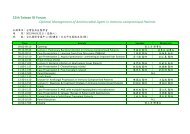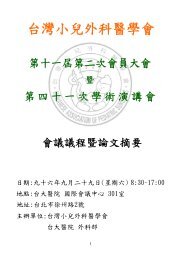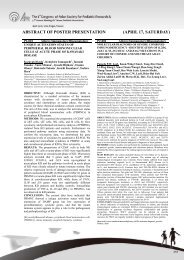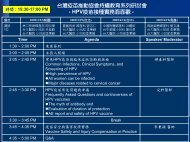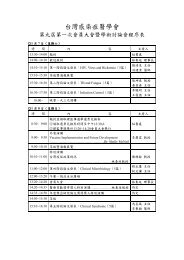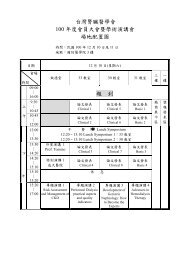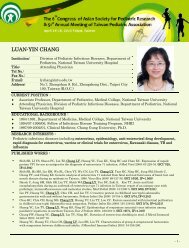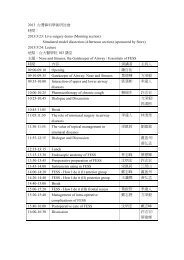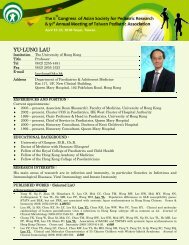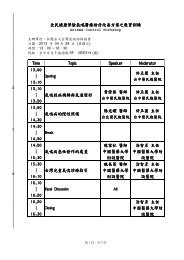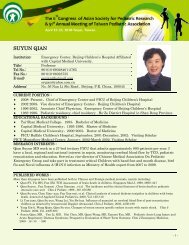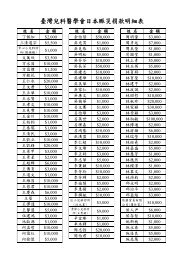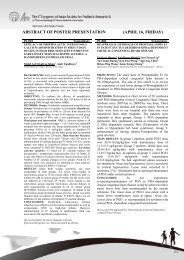ABSTRACT OF INVITED LECTURES AND ORAL PRESENTATION
ABSTRACT OF INVITED LECTURES AND ORAL PRESENTATION
ABSTRACT OF INVITED LECTURES AND ORAL PRESENTATION
- No tags were found...
You also want an ePaper? Increase the reach of your titles
YUMPU automatically turns print PDFs into web optimized ePapers that Google loves.
FP4-01A 4 YEARS <strong>OF</strong> PEDIATRIC INJURYSURVEILLANCE REVIEW BYCOMPUTERIZED EMERGENCYBASED-MODEL AT RAMATHIBODIHOSPITAL, THAIL<strong>AND</strong>Sakda Arj-ong, Nongluck TechajareonPediatric Emergency Division, Department of Emergency MedicineFaculty of Medicine, Ramathibodi Hospital, Mahidol University, Bangkok,Thailand 10400INTRODUCTION: According to the WHO Report 2002,pediatric injuries was the sixth leading cause of morbidityand mortality in childhood, there have few studies ofpediatric injury surveillance & research in Thailand. Weevaluated the type of pediatric injuries encountered in theemergency room of Ramathibodi hospital, which tertiarycare hospital to study the incidence and surveillance ofpediatric injury according to age group represent theurbanized pediatric injury incidence.OBJECTIVES & MATERIALS: Retrospective reviewswith Thai-Computerized-Emergency-Based-Model withObject-Related-Injuries-Surveillance-Survey, injured-childin ER at Ramathibodi Hospital, 0-14 years old during Jan2003 to Dec 2006 were analyzed into two categories, Firstis demographic data and second is clinical data, triage,injured-types, aged-group-relate, disposition, PediatricTrauma Score (PTS)/Revised Trauma Score (RTS) whichwere calculated each items into score, analyses insubcategories for effectiveness of ER management.RESULTS: 2,319 cases of Pediatric injured, male 61.84%, female 38.16%, mean age is 6 years old, 0-5 year’sold-group has highest incidence/risk for injury. 65.3percent is in triage categories level 2. The fifth top ranksare animal bite & string, fall, struck by against,transportation and cut injured. Almost of injured visits areminor trauma, which can observe and safety to discharge,Sexual abuse still have a higher trend than the physicalabuse and neglect, usually abuse by known person. ThePTS/RTS are not valuable for management due to minorinjury case mixed in tertiary center.CONCLUSIONS: The 4 years of retrospectivesurveillance reviews was demonstrated the trend ofpediatric injury still high, different incidence between agegroup and developmental aspects. The five top ranks ofinjuries show different incidences with western country.The future prospective surveillance and multisite,multicenter are need to reflect all incidence of pediatricinjury in Thailand.[Keywords]Pediatric Injury, Injury Surveillance, RTS, PTS,Computerized Emergency Based-Model, Injury DatabasePrototypeFP4-02DO CARGIVERS IN SAUDI ARABIA GIVE THEIRCHILDREN WITH FVER THE ACCURATE DOSE<strong>OF</strong> ACETAMINOPHEN?Fawaz Al Enazi, Nahar Alrewali, and Mohammed Al OmarKing Faisal Specialist Hospital and Research Centre, Riyadh, Saudi ArabiaOBJECTIVES: Fever contributes to significant visits ofEmergency Department (ED). Through our clinicalobservation some children were not given the accuratedose of acetaminophen. We decided to know whethercaregivers give their children with fever the accuratedose of acetaminophen and what are the factorsassociated with dose inaccuracy.METHODS: A cross-sectional study of 200 caregiverswho gave acetaminophen to their children with fever inthe preceding 24 hours was interviewed.MAIN RESULTS: Enrolment was 89 %. Seventy-sevenof caregivers (43%) gave an accurate dose ofacetaminophen. Fifty-three (30%) gave aninfratherapeutic and 48 (27%) gave supratherapeuticdoses. Caregivers who gave the accurate doses weremore likely to space acetaminophen doses less than4-hourly (RR 0.63 P < 0.04, 95% CI= 0.37 to 1.07).Patients receiving acetaminophen per rectum had asignificantly greater rate of supratherapeutic doses 9/28(32%) versus 39/149 (26%), respectively (95% CI= 0.14to 0.48). Sixteen caregivers (9%) gave more than fivedoses per 24 hours (RR1.11, 95%CI=0.74-1.67).Physicians and pharmacist were more likely to be thereferences of an inaccurate doses (RR1.2995%CI=0.95-1.75) and (RR 1.27 95%CI=0.75-2.18)respectively. Fathers and Caregivers with an educationlevel of intermediate and secondary levels were morelikely to give inaccurate doses (RR1.15,95%CI=0.76-1.73), (RR1.28 95%CI=0.91-1.79) and (RR1.20, 95%CI=0.92-1.57) respectively.CONCLUSION: Large percentage of caregivers givesan inaccurate dose of acetaminophen. Fathers,intermediate and secondary school level of education,physicians and pharmacists as a references, were morelikely to give an inaccurate doses, suggesting educationmay be valuable in ameliorating this common problem.[Keywords]Children, fever, acetaminophen, dose accuracy72



